Best
AFFORDABLE DRUMSTICK
-
Overall: Nylon tips on maple provide a balanced tone with enhanced durability
-
Best Feature: Offers a comfortable grip for extended play
-
TedScore™: 8/10
Best
OverAll Drumstick
-
Overall: Made from premium hickory that offer excellent response and durability
-
Best Feature: For traditional feel and balanced performance
-
TedScore™: 10/10
Best
PREMIUM DRUMSTICK
-
Overall: Delivers durability, responsiveness, and a distinct, warm tone
-
Best Feature: Balanced weight and feel contribute to versatile playability
-
TedScore™: 8/10
Ever wanted to **unleash your inner rockstar** on the drums, only to pause and wonder, **”How long are drumsticks, really?”** 🌟
As a seasoned professional musician, I’ve spent years perfecting my drumming skills, from the early days of learning the basics to performing on grand stages with acclaimed bands, where the rhythm of the crowd matched the beat of my drumsticks.
In this article, we’re delving into the crucial dimensions that can elevate your drumming sessions to new heights.
Whether you’re a seasoned pro or just starting out, understanding the nuances of drumstick lengths can make a world of difference in your performance.
Get ready to become a drumstick connoisseur as we explore the essential sizes and how they can impact your drumming style and technique.
Stick around (!) because you’re about to gain expert insight into the world of drumsticks!
Common Drumstick Lengths and Their Uses
When you’re choosing drumsticks, length matters as much as the grip! From quick jazz flicks to the deep pound of rock, the right length sets the stage for your playing style.
Standard Drumstick Lengths and Their Different Applications
7A: 15"-15.75"
Ideal for:
- Jazz
- Light, fast playing
- Smaller hands or venues
5A: 16"
Ideal for:
- General use
- All music styles
- Balanced control
5B: 16" but thicker than 5A
Ideal for:
- Rock
- Loud playing
- Durable, solid feel
2B: 16" but very thick
Ideal for:
- Hard rock or metal
- High energy playing
- Maximum volume
Renowned Drummers and Their Choice of Drumstick Length
Renowned drummers have long understood the impact of drumstick length on their playing style.

Take Travis Barker, for example, who swears by his longer sticks for that extra reach, enabling him to deliver powerful beats with unparalleled precision.
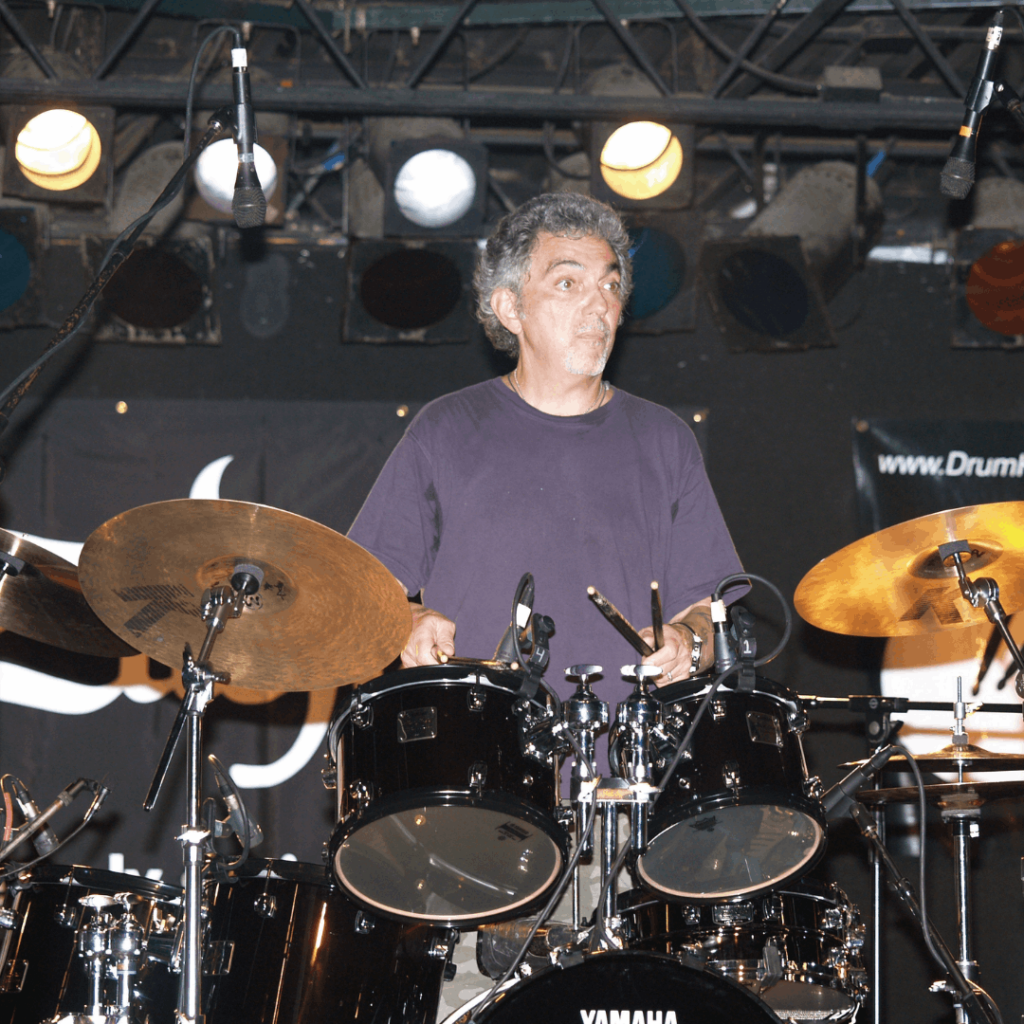
On the other hand, Steve Gadd’s preference for shorter 5A sticks allows him to echo with remarkable accuracy in each session, showcasing the finesse of his drumming technique.

Then there’s Tommy Aldridge, whose choice of 2B sticks enables him to slice through heavy metal with sheer power, creating an intense and commanding presence on stage.
These drumming icons didn’t achieve their mastery overnight – they, too, began by experimenting with different stick lengths to find their perfect match, just like you are doing now.
The Impact of Drumstick Length
Selecting the ideal drumstick isn’t just about feel; it’s about how the length influences your style and sound. Let’s break down the nitty-gritty of how these choices can shape your drumming journey.
Drumstick Length and Playing Style

When you pick up a drumstick, its length is a silent signal for your playing style. Longer drumsticks extend your reach and are often sought by drummers who love to play big, theatrical shows. They can help you strike cymbals and percussion that are set farther away with ease.
Longer sticks also grant you more reach and can aid in techniques like cymbal swells and broad sweeps, perfect for when you want to exaggerate a fill.
With a longer drumstick, you’ll find they bring a heavier weight that can translate to a louder volume — perfect for making your presence known.
On the other hand, a shorter drumstick brings everything in close, ideal for intricate pieces where precision and subtlety take the lead.
They tend to offer greater balance and control, perhaps lowering the volume but amping up the finesse.
Bear in mind that with every inch added, weight increases, which can shift the balance point.
Importance of Choosing the Right Drumstick Length

It’s personal! The right length of your drumstick directly affects your comfort and the longevity of your play.
Think about your hand size and arm length. Does a 16-inch drumstick feel like wielding a magic wand, or would a compact 15-inch serve you better in the long drumming sessions ahead?
Remember, your drumsticks are your tools; picking the length that feels like an extension of your arm is the key to a comfortable and successful drumming experience.
Finding your perfect drumstick length is more than just picking up any pair. It’s an art that considers your unique style, technique, and physicality, ensuring every strike resonates with your personal touch.
Factors Affecting Drumstick Length
When you pick up a drumstick, it’s not just a stick of wood—its length can shape your musical experience. Here’s how:
Player Preference and Comfort

Your own preference plays a huge role in drumstick length. It’s like choosing a comfortable pair of shoes; the right fit matters.
Some of you may prefer longer sticks for that extra reach around the kit, while others might find shorter ones give you a feeling of more control. It boils down to what feels good in your hands and allows you to play your best.
The Role of Drumming Genre and Musical Context
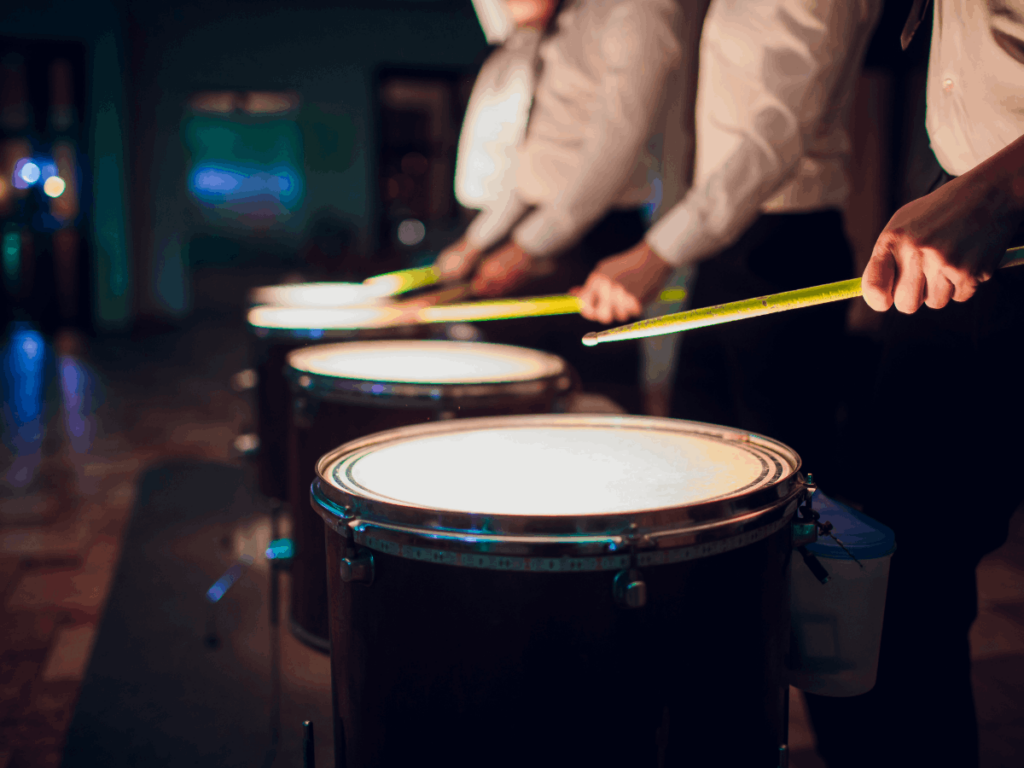
Think about the music you play as if it’s a character in a story, with every genre having its own personality. Drumsticks are the tools that help you bring that character to life.
In jazz, where finesse and a softer touch are king, you might lean towards a slimmer and shorter stick. In contrast, rock or metal drumming often calls for a longer stick that can deliver the power and volume you need to cut through amplified instruments.
Impact of Drumstick Length on Muscle Fatigue and Playing Dynamics

The length of your drumstick can be like the spoon in your morning coffee stirring in sugar. A longer stick, while allowing for a broader dynamic range, may also add a bit more weight, possibly leading to faster muscle fatigue.
This trade-off means you need to find the sweet balance between dynamic expression and your playing stamina. After all, you want to play to the last beat of the encore, not tap out mid-solo!
Selecting the Right Drumstick Length
Selecting the proper drumstick length is as crucial as choosing the right pair of shoes. It can enhance your playability and comfort, so let’s ensure you find your perfect match.
Discovering your ideal drumstick length isn’t just about adhering to a standard; it’s about uncovering what feels best for you.
Typically, drumsticks range from 15 to 17.5 inches in length. To start on the right foot, consider the following steps:
Step 1: Measure your hand

Drumsticks should feel like a natural extension of your arm.
Before choosing the perfect drumstick length, it’s essential to consider how they feel in your hands. Drumsticks should seamlessly integrate with your natural grip, feeling like an extension of your arm as you unleash your rhythmic prowess.
Take a moment to measure your hand and consider the balance and comfort of different sticks lengths, ensuring that they complement your playing style and technique.
Step 2: Check your reach

Longer sticks provide more reach but can also be heavier.
The length of your drumsticks can significantly impact your reach and playing dynamics. Longer sticks offer extended reach, allowing for powerful strokes and a broader range across the drum kit.
However, it’s important to note that longer sticks can also carry additional weight, which may affect your endurance and agility during extended playing sessions.
Consider how the length of the sticks aligns with your performance needs and comfort, finding the perfect balance between reach and maneuverability.
Step 3: Visit a music store

Try out various lengths to see what suits your playing posture.
A trip to a music store can be an invaluable opportunity to explore the diverse range of drumstick lengths and find the ideal match for your playing posture.
Trying out different sticks in person allows you to assess how they feel in your hands, complement your playing posture, and resonate with your drumming style.
Experimenting with various lengths in a music store provides firsthand insight into the nuanced differences between drumsticks, empowering you to make an informed decision that enhances your drumming experience.
Remember, it’s not a one-size-fits-all situation. Here’s why experimentation is key:
Various musical styles call for different stick lengths.
Grip and technique may change, demanding adaptation in stick length.
Let curiosity lead you and don’t be afraid to switch things up based on your current gig or the genre you’re mastering.
Potential Benefits of Customizing Drum Stick Length to Your Playing Style
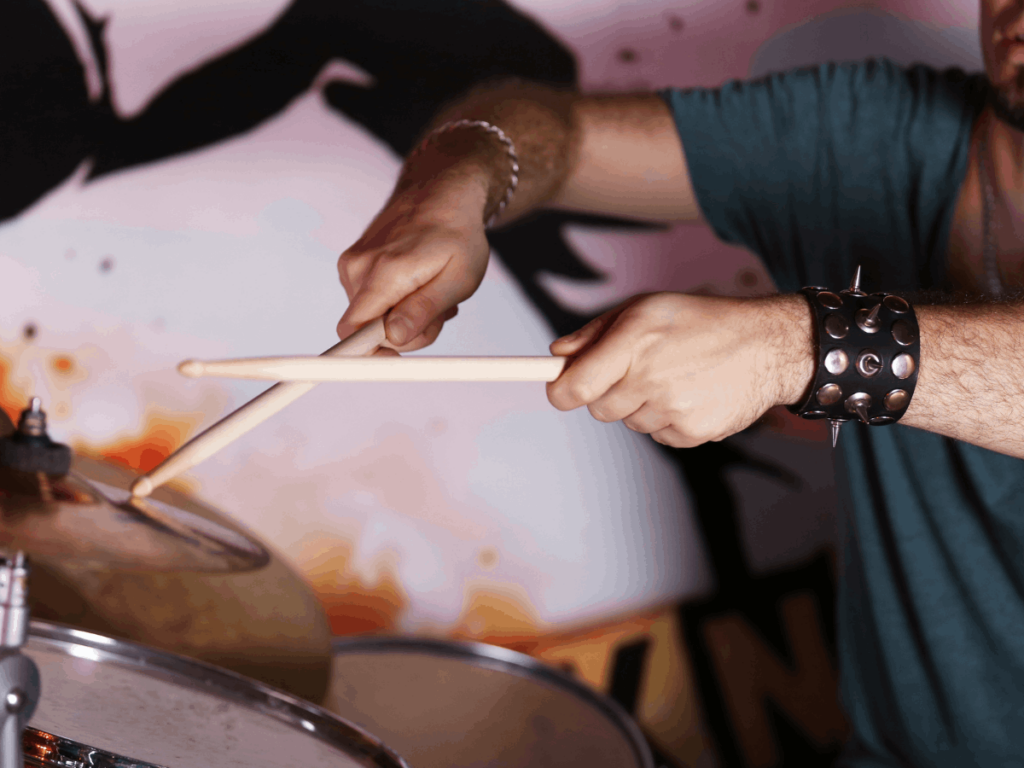
Tailoring drumstick length to your playing style reaps rewards like:
Enhanced dynamics: The perfect stick length can help you effortlessly achieve soft touches or powerful accents.
Reduced fatigue: A drumstick that fits like a glove could mean longer sessions without cramping.
Think of drumsticks as your musical paintbrushes. The length influences every stroke you make on the canvas of rhythm.
But wait, did you also know that the drumstick tip material is also crucial to the sound and feel of your drumming?
Whether nylon, wood, or felt, each material offers a distinct tone and response when striking the drum surface.
Nylon tips provide a bright and articulate sound, ideal for cymbal definition and precision, while wood tips deliver a warmer and fuller tone, perfect for a classic, natural feel.
On the other hand, felt tips produce a mellow and soft sound, making them well-suited for low-volume playing and creating a smooth, controlled impact on the drums.
Moreover, the drumstick tip shapes, whether round, barrel, or acorn, significantly influence the sound and articulation when striking the drum surface.
Our Highly Recommended
Top 3 Drum Drumsticks
Best Drumsticks for Children
Vic Firth American Classic 5A Hickory
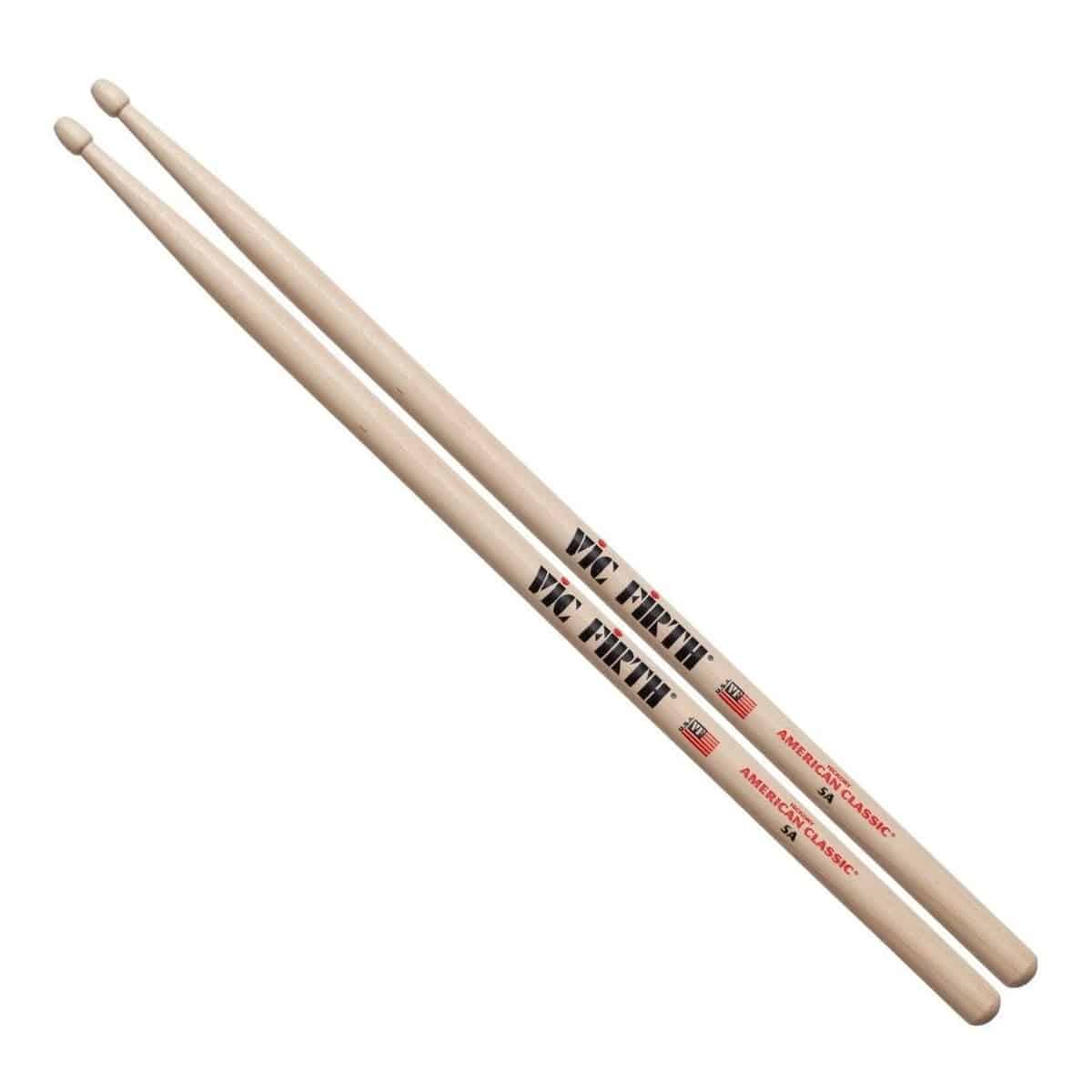
COMES WITH: Hickory
FEATURES: Superior Durability frequencies
Vic Firth American Classic 5A Hickory
- Versatile
- Hickory is durable
- Does not give the bright sound you can achieve with a nylon tip
When you click ‘Check Price’, you’ll see there are loads of great places to buy this item. Our personal favorite is Sweetwater for the US, and Thomann and Gear4Music for the UK & Europe.
They are the largest music retailers, with excellent customer service, competitive prices, really fast shipping, and the longest guarantees.
The professional musician who wrote this article combined many things,
from the product build, manufacturer’s reputation through to feedback
from other users, to create our famous TedScore™.
Best Drumsticks for Durability
Jack Daniel's Old No. 7 5A Hickory Drumsticks
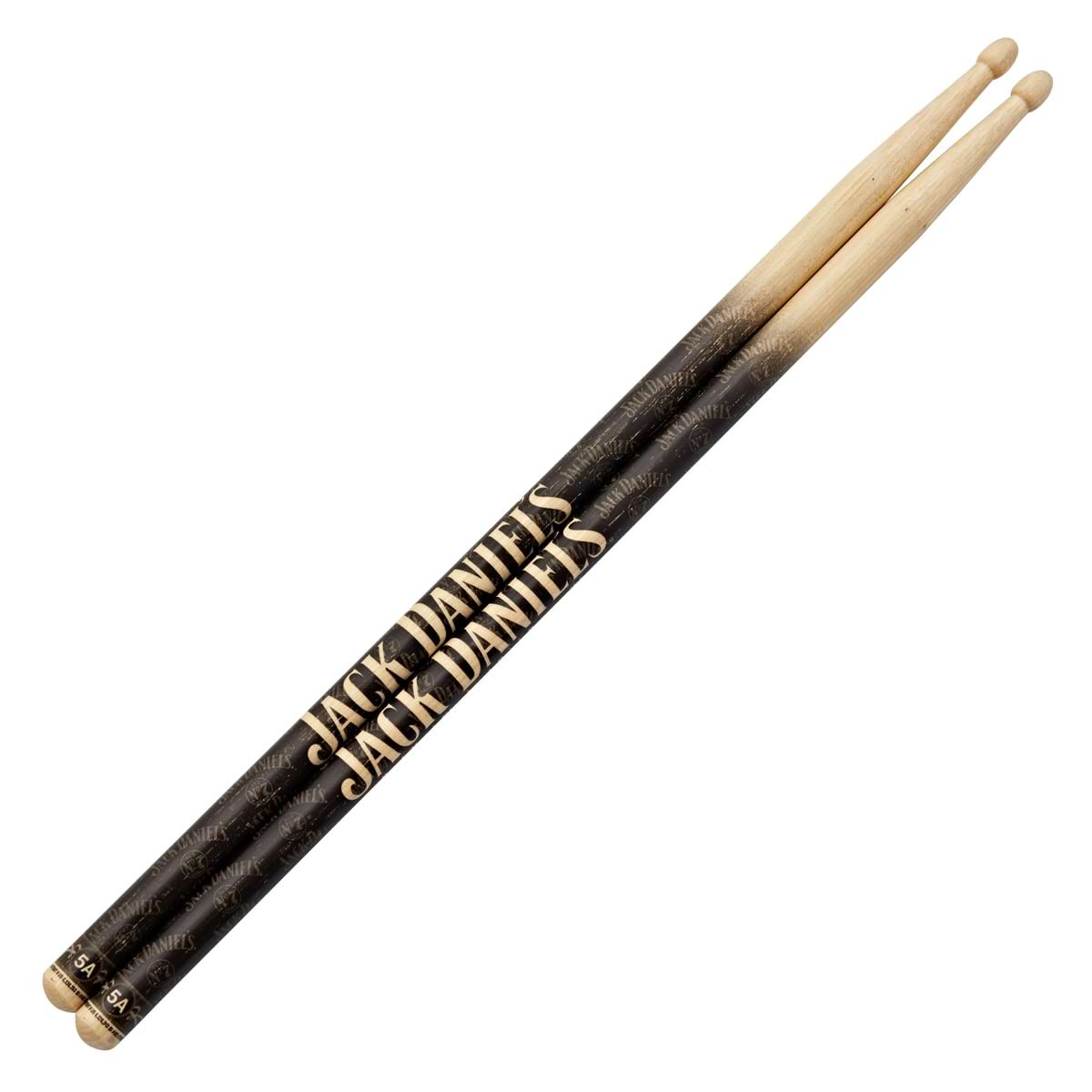
FEATURES: Crafted with hickory wood
OTHER INFO: Produced by Peavey - fully licensed by Jack Daniel's
- Durable 5A hickory construction ensures longevity during intense drumming sessions
- Balanced weight and feel contribute to versatile playability across different music genres
- Slightly higher price point compared to generic drumsticks
When you click ‘Check Price’, you’ll see there are loads of great places to buy this item. Our personal favorite is Sweetwater for the US, and Thomann and Gear4Music for the UK & Europe.
They are the largest music retailers, with excellent customer service, competitive prices, really fast shipping, and the longest guarantees.
The professional musician who wrote this article combined many things,
from the product build, manufacturer’s reputation through to feedback
from other users, to create our famous TedScore™.
Best Drumsticks for Precision in Play
2B Nylon Tip Maple Drumsticks
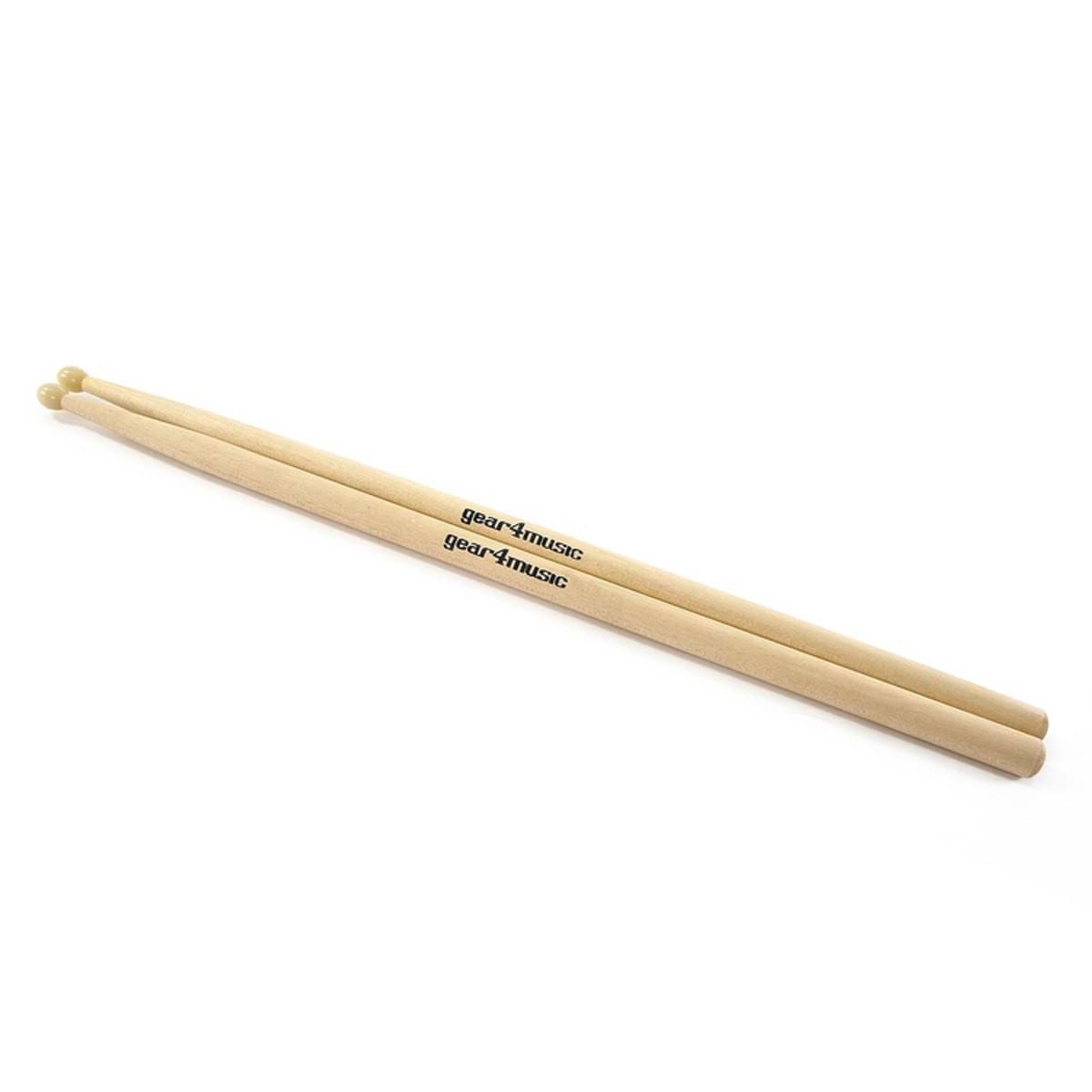
FEATURES: Nylon tips for enhanced durability and clear cymbal definition
OTHER INFO: Crafted for various music genres
- Durable nylon tips for extended lifespan
- Comfortable grip for prolonged playing sessions
- Versatile for different music styles
- Slightly heavier compared to all-wood sticks
When you click ‘Check Price’, you’ll see there are loads of great places to buy this item. Our personal favorite is Sweetwater for the US, and Thomann and Gear4Music for the UK & Europe.
They are the largest music retailers, with excellent customer service, competitive prices, really fast shipping, and the longest guarantees.
The professional musician who wrote this article combined many things,
from the product build, manufacturer’s reputation through to feedback
from other users, to create our famous TedScore™.
The Future of Drumstick Design

The drumstick materials of the future will revolutionize traditional designs, with innovative options like carbon fiber offering enhanced durability and performance.
These futuristic drumsticks may also include specialized coatings or grips, such as aluminum foil wrapping, ensuring a secure hold and preventing slips during intense drumming sessions.
Plus, there’s potential for drum sticks to be ergonomically tailored to fit the unique shape of your hand, providing comfort tailored to your individual playing style.
In the digital age, drumstick design goes beyond length and reach, focusing on precision and innovation.
Imagine telescopic drumsticks that can dynamically adjust their length mid-performance, offering drummers flexibility to adapt to different playing styles seamlessly.
This technological evolution enhances the overall drumming experience, like upgrading from basic to gourmet, adding a touch of high-tech finesse. With technology shaping the future of drumstick design, the potential for enhancing performance and creativity knows no bounds.
How Long Are Drumsticks
Summary
You’ve just taken a wild ride through the drumstick universe! Back in the day, I was just a young whippersnapper learning the ins and outs of drumming.
Most drumsticks you’ll come across hover around 16 inches long, setting a familiar rhythm for countless drummers.
But hey, it’s not a one-size-fits-all deal—some drummers groove with longer sticks, while others cozy up to shorter ones.
If you’re still pondering, here’s a handy tip: 5A is perfect for beginners, while the 7A is a lighter stick that’s hit with young drummers and jazz enthusiasts. And if you’re after some serious oomph, the hefty 2B might just be your jam.
Embrace the diverse range of drum stick sizes, and you’ll be commanding the stage like a seasoned pro, whether you’re jamming to jazz, rocking out, or carving your own unique style. Now, go on and let those sticks boogie to your own beat!
Wait, there’s more!
Get ready to unleash your inner rhythm master with the ultimate guide to Drums for Beginners!
FAQ's
5A drumsticks are typically around 16 inches in length. These drumsticks are a popular choice for many drummers due to their versatile size and weight, making them suitable for various styles of drumming. The standard length of 5A drumsticks provides a comfortable and balanced feel for most drummers.
5A drumsticks are generally bigger than 7A drumsticks. The 5A size is a slightly thicker stick and longer compared to the 7A, providing a different feel and balance when playing. The size and weight variances between the two drumsticks can impact the sound and style of drumming.
Yes, 7A drumsticks are considered small and thin sticks compared to other sizes. They are lighter and thinner, making them suitable for drummers who prefer a lighter and more delicate touch. The smaller size of 7A drumsticks can offer greater control and agility during drumming.
A 2B drumstick is typically around 16 to 16.5 inches in length. These drumsticks are known for their larger size and heavier stick weight, making them suitable for drummers who require more power and durability. The extended length of 2B drumsticks provides a comfortable grip and enhanced reach for playing.










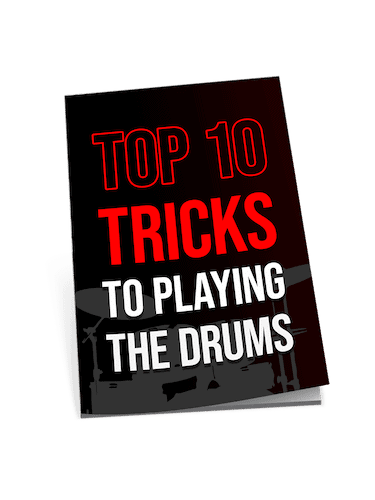
Dave Danford, awesome rundown on the intricacies of drumstick selection! It’s a topic many overlook but can drastically change one’s playing experience. From my days behind the drum kit to now working on digital beats, the feel and flow that comes with the right stick can’t be overstated. I’d add that those transitioning from acoustic to electronic drum kits also consider the impact of stick length on their play. Sometimes the bounce back from electronic pads feels different, and adjusting stick length can help mitigate that. Plus, experimenting with various lengths might inspire new rhythms or techniques that could innovate one’s style. Keep up the great work; it’s articles like these that help bridge the gap between traditional musicianship and modern music production.
hey, does anyone know if stick length changes like a lot if ur playing metal?? kinda want to play fast but dunno what sticks to pick lol
Interesting points on drumstick lengths, but I believe there’s a bit more nuance to it, especially in jazz versus rock settings. Drumstick thickness and the material can also play significant roles in the sound produced and the overall control a drummer has. While length is important, it’s not the only factor to consider. Would be great to see a follow-up article discussing these aspects too.
Absolutely agree with iReadNotes. Material and thickness are crucial aspects as well. I’ve found that maple sticks, for example, offer a different experience than hickory or oak in terms of flexibility and rebound.
Just want to say, as someone who’s just starting out on the drums, this article is a goldmine! Never knew there was so much to consider about drumstick lengths. I’ve been using whatever sticks came with my kit, but after reading about how the length can influence playing style and even prevent muscle fatigue, I’m thinking I should experiment a bit. Thanks for breaking it down so clearly, Dave Danford. Off to measure my hand!